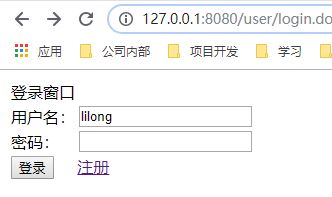使用Session和Cookie做登录验证
1 背景
作为“自学成才”的野路子程序员,一直忙于CRUD,没有系统地学习CS基础知识,导致面试的时候屡屡被CS专业的同学diss,于是乎知耻而后勇,认认真真地补习基础知识,这篇博客就来学习、总结下啥是Cookie、啥是Session。
以前看过面试宝典,只知道Cookie是保存在客户端、Session保存在服务端,除此之外一无所知,直到昨天晚上躺在床上辗转反侧、思绪万千,看了一篇关于单点登录的博客,才恍然大悟:这俩玩意是用来校验用户登录状态的。因为http是无状态的,所以客户端每次向服务端发起请求的时候,服务端是不认识客户端的(服务端:我这个人脸盲,就是说分不清谁漂亮谁不漂亮),那么为了搞清楚用户是否已登录,就要有一种机制来分辨不同的客户端。
区别:Session是服务端的东西,用户是看不到的;Cookie是客户端的东西,用户能看得到,但是不能跨域请求。
客户端第一次访问服务端时,服务端会生成一个sessionId并返回给客户端,客户端给保存到cookie中,按下F12打开开发者模式,看到请求头:Cookie:JSESSIONID=xxxxxxxxxxxxxxxxxxx 这一串就是服务端为请求生成的sessionId。
本文用到的代码已经托管在github上了:
(1)登录校验
https://github.com/hfutlilong/test/blob/master/src/main/java/filter/LoginFilter.java
https://github.com/hfutlilong/test/blob/master/src/main/java/controller/LoginController.java
https://github.com/hfutlilong/test/blob/master/src/main/java/controller/MainController.java
(2)各种JSP页面
https://github.com/hfutlilong/test/tree/master/web/WEB-INF/views
2 用Session校验用户登录状态
2.1 登录状态验证
我们通过在session中设置属性“isLogin”来标识登录状态,登录的时候置为true、退出的时候置为false,是不是很神奇,请叫我的全名——达文西。
用Filter过滤器来校验用户登录状态。过滤器是Servlet的,拦截器是Spring的,优先级的话过滤器要高于拦截器。
很简单,我们实现Filter接口,重写doFilter()方法:
package filter;
import javax.servlet.*;
import javax.servlet.http.HttpServletRequest;
import javax.servlet.http.HttpServletResponse;
import javax.servlet.http.HttpSession;
import java.io.IOException;
public class LoginFilter implements Filter {
@Override
public void init(FilterConfig filterConfig) throws ServletException {}
@Override
public void destroy() {}
@Override
public void doFilter(ServletRequest request, ServletResponse response,
FilterChain chain) throws IOException, ServletException {
HttpServletRequest req = (HttpServletRequest) request;
HttpServletResponse res = (HttpServletResponse) response;
HttpSession session = req.getSession();
String uri = req.getRequestURI();
boolean isLoginReq = uri.matches("/user/.*\\.do");
boolean isLogin = session.getAttribute("isLogin") != null
&& (boolean)session.getAttribute("isLogin");
if (isLoginReq || isLogin) {
chain.doFilter(request, response);
return;
}
//跳转至登录页面
res.sendRedirect("/user/login.do");
}
}
然后配置在web.xml中:
loginFilter
filter.LoginFilter
loginFilter
/*
2.2 登录与退出
写一个处理登录、退出的Controler:
@Controller
@RequestMapping("/user")
public class LoginController {
@Autowired
private UserLoginService userLoginService;
@RequestMapping("/login")
public String login() {
return "login";
}
@RequestMapping("/loginAction")
public String loginAction(String username, String password, HttpServletRequest request, HttpServletResponse response) {
UserLoginVO userLoginVO = userLoginService.queryUserByNamePwd(username, password);
if (userLoginVO != null) {
request.getSession().setAttribute("isLogin", true);
return "welcome";
}
return "login";
}
@RequestMapping("/logout")
public void logout(HttpServletRequest request, HttpServletResponse response) {
request.getSession().removeAttribute("username");
try {
request.getSession().setAttribute("isLogin", false);
response.sendRedirect("/user/login.do");
} catch (IOException e) {
e.printStackTrace();
}
}
}
2.3 业务代码
好吧,其实就是hello world:
@Controller
@RequestMapping
public class MainController {
@RequestMapping(value = "/hello", method = RequestMethod.GET)
public String hello(){
return "hello";
}
}2.4 JSP页面
不要问我为什么还在用JSP,因为我只是个后端小码仔,不会写前端,就会一点点JSP。。。嗯,真香
登录页面长这样子:
3 用Cookie校验用户状态
session保存在Map结构的内存中,默认的过期时间是30分种,那像有些网站可能关闭之后、过了几天再去打开也仍然不需要登录,这种其实就是用Cookie校验了,不然的话内存会撑爆的。
实现方式:在Cookie中增加"username"属性,如果访问的请求中,cookie包含该属性,那就认为是登录状态。
与上面类似,也是实现一个Filter接口、登录时保存Cookie、退出时清除Cookie,但是Cookie没有删除方法,所以需要设置Cookie有效期为0秒,即可删除。
3.1 过滤器:根据Cookie判断是否已登录
public void doFilter(ServletRequest request, ServletResponse response,
FilterChain chain) throws IOException, ServletException {
HttpServletRequest req = (HttpServletRequest) request;
HttpServletResponse res = (HttpServletResponse) response;
String uri = req.getRequestURI();
boolean isLoginReq = uri.matches("/user/.*\\.do");
boolean isLogin = false;
// 判断cookie是否有username,如果有代表登陆过
Cookie[] cookies = req.getCookies();
if (cookies != null) {
for (Cookie cookie : cookies) {
if (cookie != null && URLDecoder.decode(cookie.getName(), "utf-8").equals("username")) {
isLogin = true;
break;
}
}
}
if (isLoginReq || isLogin) {
chain.doFilter(request, response);
return;
}
//跳转至登录页面
res.sendRedirect("/user/login.do");
}3.2 登录与退出
实验中我们设置Cookie过期时间为60s,那么在登录后的1分钟内是可以正常执行业务接口的,但是超过了1分钟就要重新登录。
@Controller
@RequestMapping("/user")
public class LoginController {
@Autowired
private UserLoginService userLoginService;
@RequestMapping("/login")
public String login() {
return "login";
}
@RequestMapping("/loginAction")
public String loginAction(String username, String password, HttpServletRequest request, HttpServletResponse response) {
UserLoginVO userLoginVO = userLoginService.queryUserByNamePwd(username, password);
if (userLoginVO != null) {
// 把用户名保存在Cookie里
Cookie cookie = new Cookie("username", username);
cookie.setMaxAge(60); // 单位:秒
cookie.setPath("/");
response.addCookie(cookie);
return "welcome";
}
return "login";
}
@RequestMapping("/logout")
public void logout(HttpServletRequest request, HttpServletResponse response) {
request.getSession().removeAttribute("username");
try {
//把过期时间设置成0秒,表示删除该属性
Cookie[] cookies = request.getCookies();
if (cookies != null) {
for (Cookie cookie : cookies) {
System.out.println(URLDecoder.decode(cookie.getName(), "utf-8"));
if (URLDecoder.decode(cookie.getName(), "utf-8").equals("username")) {
cookie.setMaxAge(0); // 删除cookie
cookie.setPath("/");
response.addCookie(cookie);
}
}
}
response.sendRedirect("/user/login.do");
} catch (IOException e) {
e.printStackTrace();
}
}
}
登录后可以看到cookie中新增了username:
4 总结
- session和cookie的作用:判断登录状态;
- session保存在服务端,用户不可见,有效期可设置,默认30分钟;
- cookie保存在客户端,用户可以看到;
- session的生命周期是一个会话(从打开浏览器到关闭浏览器),cookie的生命周期根据设置的过期时间值,如果没设置过期时间,则不会保存在本地,在关闭浏览器后即失效。



